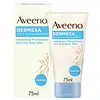What's inside
What's inside
 Key Ingredients
Key Ingredients

No key ingredients
 Benefits
Benefits

 Concerns
Concerns

 Ingredients Side-by-side
Ingredients Side-by-side

Glycerin
HumectantWater
Skin ConditioningCetearyl Alcohol
EmollientIsocetyl Alcohol
EmollientDimethicone
EmollientCetyl Alcohol
EmollientAvena Sativa Kernel Flour
AbrasiveAvena Sativa Kernel Extract
AbrasiveAvena Sativa Kernel Oil
Skin ConditioningCaprylic/Capric Triglyceride
MaskingCeramide 3
Skin ConditioningEthylhexylglycerin
Skin ConditioningP-Anisic Acid
MaskingSodium Cetearyl Sulfate
CleansingPalmitic Acid
EmollientStearic Acid
CleansingSodium Sulfate
Sodium Chloride
MaskingCitric Acid
BufferingDipotassium Phosphate
BufferingPotassium Phosphate
BufferingSodium Hydroxide
BufferingTocopherol
AntioxidantBenzyl Alcohol
PerfumingBenzoic Acid
MaskingPotassium Sorbate
PreservativeGlycerin, Water, Cetearyl Alcohol, Isocetyl Alcohol, Dimethicone, Cetyl Alcohol, Avena Sativa Kernel Flour, Avena Sativa Kernel Extract, Avena Sativa Kernel Oil, Caprylic/Capric Triglyceride, Ceramide 3, Ethylhexylglycerin, P-Anisic Acid, Sodium Cetearyl Sulfate, Palmitic Acid, Stearic Acid, Sodium Sulfate, Sodium Chloride, Citric Acid, Dipotassium Phosphate, Potassium Phosphate, Sodium Hydroxide, Tocopherol, Benzyl Alcohol, Benzoic Acid, Potassium Sorbate
 Reviews
Reviews

Ingredients Explained
These ingredients are found in both products.
Ingredients higher up in an ingredient list are typically present in a larger amount.
Glycerin is already naturally found in your skin. It helps moisturize and protect your skin.
A study from 2016 found glycerin to be more effective as a humectant than AHAs and hyaluronic acid.
As a humectant, it helps the skin stay hydrated by pulling moisture to your skin. The low molecular weight of glycerin allows it to pull moisture into the deeper layers of your skin.
Hydrated skin improves your skin barrier; Your skin barrier helps protect against irritants and bacteria.
Glycerin has also been found to have antimicrobial and antiviral properties. Due to these properties, glycerin is often used in wound and burn treatments.
In cosmetics, glycerin is usually derived from plants such as soybean or palm. However, it can also be sourced from animals, such as tallow or animal fat.
This ingredient is organic, colorless, odorless, and non-toxic.
Glycerin is the name for this ingredient in American English. British English uses Glycerol/Glycerine.
Learn more about Glycerin